It’s that time of year folks, Sage Grouse are displaying on the lek. But photographers had best be prepared for extreme changes in lighting conditions and action from the displaying and fighting males.
Typically you’ll arrive at the lek in the very early morning before the grouse show up so your arrival doesn’t disturb them and make them fly off. That means being there long before dawn and suffering in the cold. The males often begin performing when it’s still dark so the photographer has some difficult choices to make regarding extremely challenging shooting conditions.
The following photos were taken on a lek on March 29, several years ago.
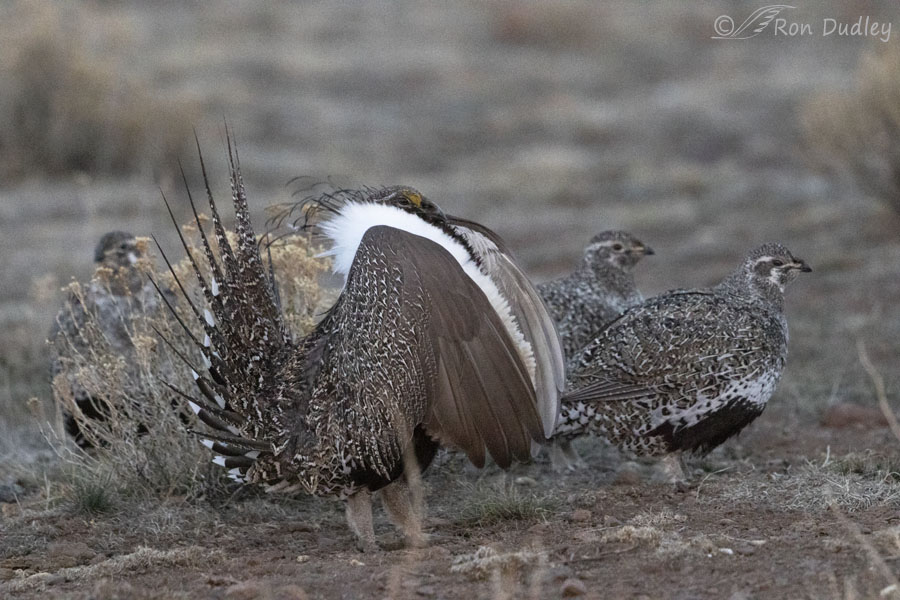
1/500, f/6.3, ISO 8000, Canon 7D Mark II, Canon EF 500mm f/4L IS II USM + EF 1.4 III Extender, not baited, set up or called in
7:13 AM: On this morning it was still nearly pitch black when the grouse started arriving. I could barely see them so trying to photograph them in those conditions would have been fruitless so I just waited in the cold and froze my butt off (engine off of course so no heat). It goes against the grain of the bird photographer to be in the presence of such spectacular birds performing fascinating behaviors and not photographing them but that’s mostly what I did. My shutter finger was twitching so it wasn’t easy.
By 7:13 it was still quite dark (much darker than it looks like it is in this photo) but by cranking my ISO up to 8000 I was able to get a shutter speed of 1/500 sec so I started firing away. The result was images with noticeable digital noise (due to high ISO’s) but how could I not try anyway? I still enjoy some of these photos and I like this one because we see several of the females that the male is performing for.
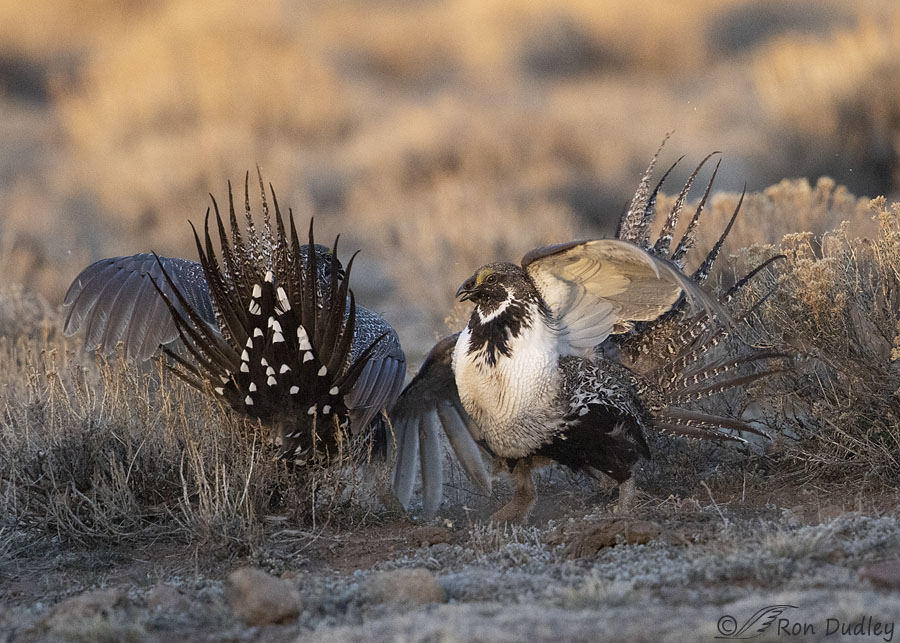
1/1600, f/5.6, ISO 4000, Canon 7D Mark II, Canon EF 500mm f/4L IS II USM, not baited, set up or called in
7:32 AM: Nineteen minutes later light was just beginning to reach some of the grouse but it was still very low so I chose ISO 4000 to give me enough shutter speed (barely) to photograph the action of fighting males.
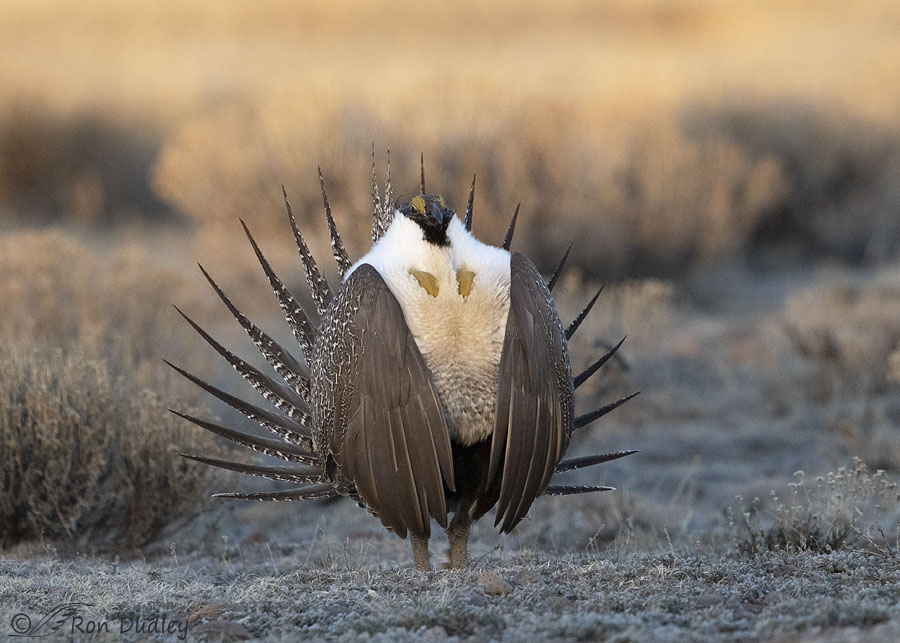
1/800, f/6.3, ISO 2000, Canon 7D Mark II, Canon EF 500mm f/4L IS II USM + EF 1.4 III Extender, not baited, set up or called in
7:32 AM: At roughly the same time I was able to reduce my ISO by half to photograph this displaying male because the action was much slower.
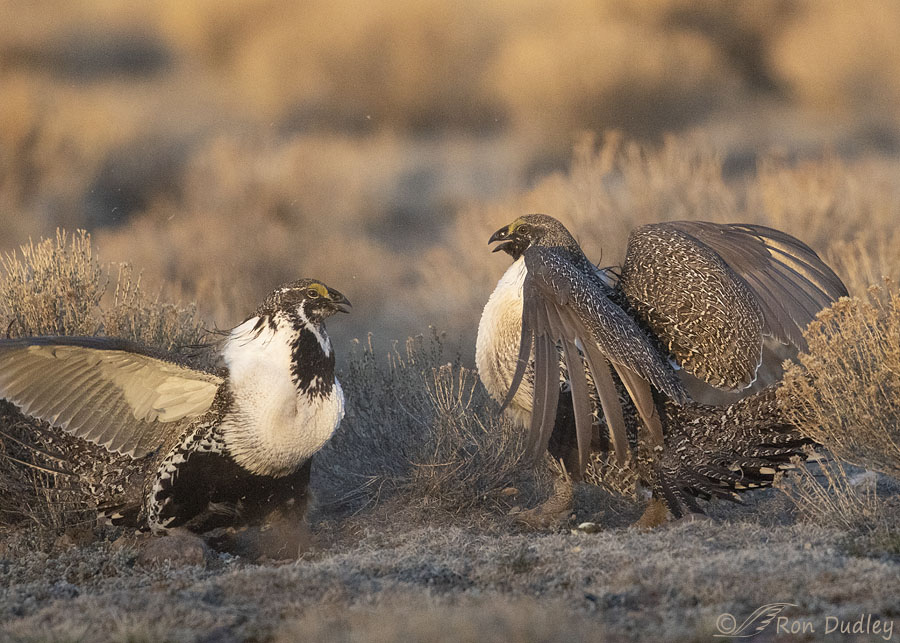
1/2500, f/5.6, ISO 4000, Canon 7D Mark II, Canon EF 500mm f/4L IS II USM + EF 1.4 III Extender, not baited, set up or called in
7:33 AM: But it’s hard to ignore fighting males so I focused on them whenever I could. At ISO 4000 there’s noise in this photo but even with the noise I’d rather have a unique shot like this than “just” another photo of a displaying male (despite the cut off wing and tail that aggravated me to no end).
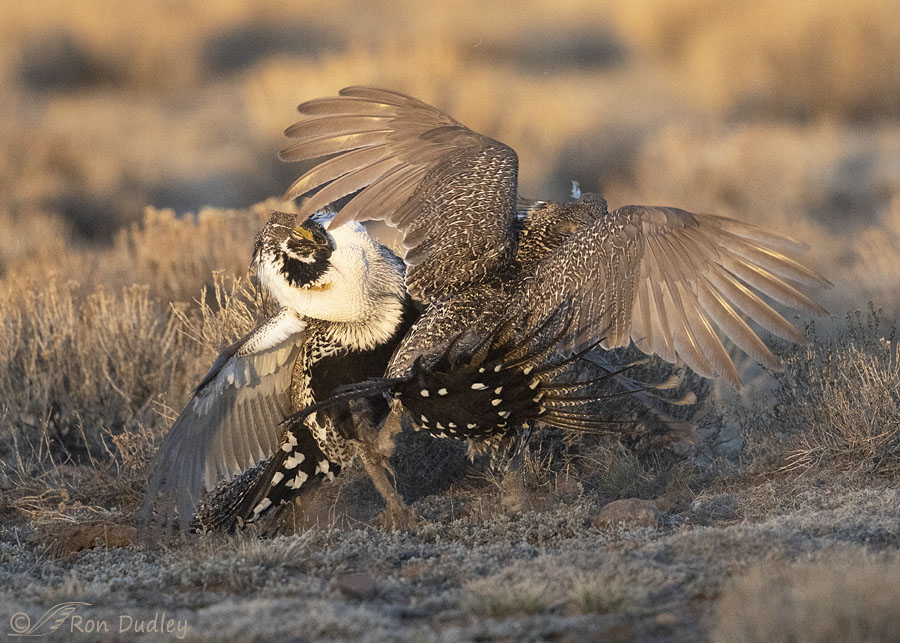
1/2500, f/5.6, ISO 4000, Canon 7D Mark II, Canon EF 500mm f/4L IS II USM + EF 1.4 III Extender, not baited, set up or called in
7:33 AM: The males really went at it.
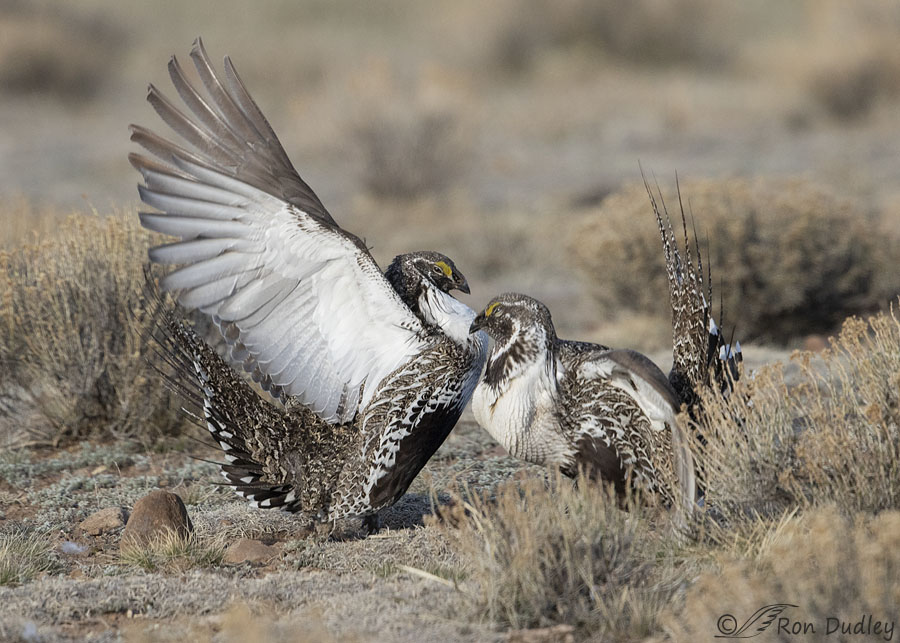
1/2500, f/7.1, ISO 1600, Canon 7D Mark II, Canon EF 500mm f/4L IS II USM + EF 1.4 III Extender, not baited, set up or called in
8:25 AM: Fifty two minutes later there was enough light to cut my ISO to 1600 and shoot at f/7.1 (to give me a little more depth of field for multiple birds) and still have enough shutter speed to freeze their incredibly fast-moving wings. They were slapping each other with their wings, which is why both birds have their eyes partially closed.
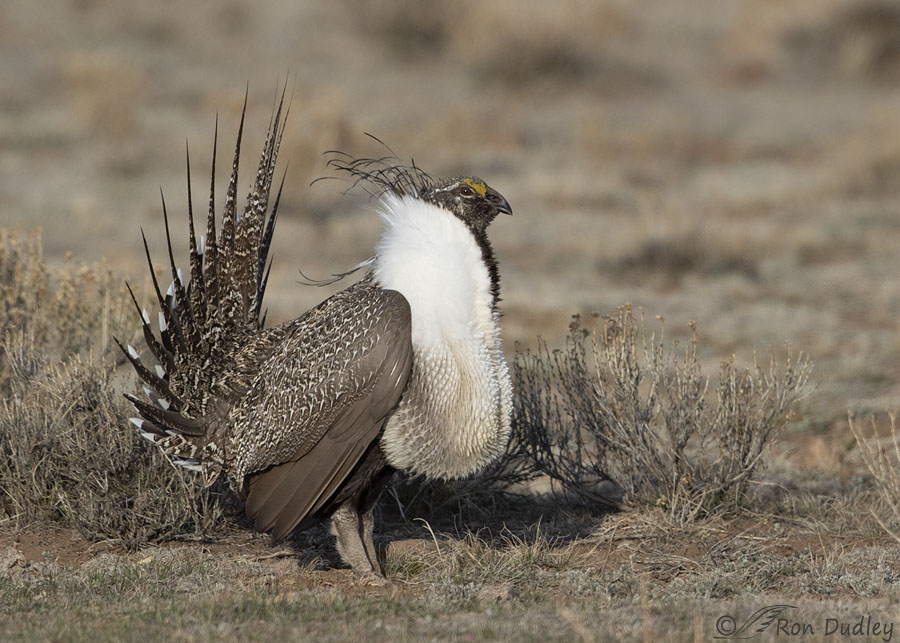
1/2000, f/7.1, ISO 800, Canon 7D Mark II, Canon EF 500mm f/4L IS II USM + EF 1.4 III Extender, not baited, set up or called in
8:16 AM: By this time when the males weren’t fighting I could use more reasonable ISO’s. The tradeoff is that the light isn’t as warm and pretty.
By the time I left the lek I felt like I’d been through the wringer. I’d spent almost two hours furiously spinning wheels and pushing buttons as I changed my camera settings in response to rapidly changing light and extremes of action from the grouse as they posed, strutted and fought. During my days in the classroom I always thought that teachers make more decisions in a given amount of time than just about anybody but photographing grouse on a lek has teaching beat.
It was tense and exciting and you really have to concentrate on what you’re doing but I wouldn’t have missed if for the world. So if you’re a photographer and you have the opportunity, take it. But you’d better know your camera and how to use it quickly and instinctively or you’re going to botch some exciting opportunities.
Ron


I don’t see myself sitting on the prairie in the wee cold hours anytime soon (although I have waded the tide pools at midnight in winter looking for baby sea stars here in Washington). However, I do appreciate seeing your photos of another species (also in trouble, as it happens).
Thanks, Lyle. Yes, they are in trouble and the current administration is making it worse.
Thank you.
This happy snapper would be too engrossed to remember to apply the trigger finger – and would have failed if she had remembered.
What an amazing experience to see, to hear, to marvel at.
Despite the cold.
Huge thanks again.
I dunno, EC – get a camera with a long lens in your hands and you never know how you’d react. Thanks.
Thank you for braving the conditions to get these fantastic shots!
Perhaps you can invent a glove with a removable or flippable “trigger finger” section — or modify a glove so just your “trigger finger” is naked. Would that work or would it mess up changing the other camera settings? Ronaldo Dudlevinci has a nice ring to it. 😉
Marty, I actually have a glove similar to the one you describe but I don’t like it. The material is too thin to do much if any good.
Outstanding work under very trying conditions Ron. Years of experience showing here for sure. Thanks for sharing these beautiful shots.
Thank you, Everett.
Great shots under duress. Time to invest in a heated viewfinder?
Thanks, Brett. You could be right…
Terrific and inspirational photos, Ron, and perfect timing on this post … I have just started a trip to Colorado to visit several leks. A few years ago I went to Nebraska to see the crane migration and fell in love with prairie chickens. I still remember the cold and the changing light, but oh! those birds! Thanks for the tips on taking photos- were you shooting manual at that time? I have switched from manual to (more often) aperture after reading your blog. Hope I am up to the challenge.
I’m excited for you Nancy, good luck.
No, I was shooting in aperture priority. I always do. It’s my theory that either one works but I prefer to use one of them constantly so I know it better and more instinctively so I don’t have to “think about it” quite so much.
Wow, what great shots. Two hours in the pressure-cooker, man that’s a long, long time! Do you have any trouble with your fingers going numb from the cold?
Great job recounting this story.
Holy hell, yes! Fingers and toes! I had hand warmers in both my gloves and my shoes but they helped very little, especially since most of the time I couldn’t keep my “shooting hand” in the glove.
The other problem was my viewfinder fogging up when I’d forget and breathe on it just a little. At those temps it takes a while for the fog to clear and I missed many nice shots because of it.
“Pressure cooker” is a great way to put it, Dave – except that implies heat that sure wasn’t there…
How amazing! I love the one where you can see the fur…errrr feather…flying.
Those males were serious about their fighting, Arwen. I almost expected body parts to fly off.
WOW! Some wonderful shots, Ron – noise and clipped wing be damned! 🙂 The fights with half closed/closed eyes are amazing. 😉 I’m surprised they were out in the dark and very low light! I was thinking before you said it about “knowing you’re camera” and being to change settings rapidly on “auto pilot” – it would be all over by the time I got there! 😉
It was “all over by the time I got there” for me many times too, Judy. But knowing my camera sure increased my batting average.
OMG, Ron!! Such spectacular captures!! These bring back memories of the PBS Sagebrush special which provided a lot of time on the special for these wonderful Grouse. If I remember right, you are the one who told me about it. In fact I think they also spent time filming Burrowing Owls – the clowns of the Owl world. If you want to see variety – just watch birds!!!
Jo Ann, The Sagebrush Sea was a wonderful documentary. Yes, I think I promoted it here on Feathered Photography.
Ahhhhh! The bone-chilling cold of the lek at dawn! I love the ethereal sounds that the various grouse make while you’re waiting for the show to begin. Your photos bring back wonderful memories. Thanks, Ron!
Yup, I remember the cold almost as well as I do the grouse, Diane. I don’t think I’ve ever been colder while photographing birds and that’s saying something.